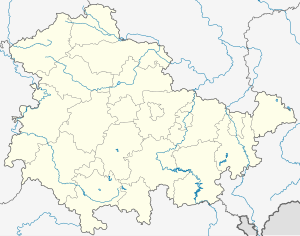Krämerbrücke
Coordinates: 50 ° 58 ′ 43 ″ N , 11 ° 1 ′ 51 ″ E
| Krämerbrücke | ||
|---|---|---|
| Krämerbrücke north side | ||
| Convicted | Gera | |
| place | Erfurt | |
| overall length | 79 m | |
| width | 26 / 5.5 m | |
| location | ||
|
|
||
The Krämerbrücke is the oldest secular building in Erfurt and is one of the most famous landmarks of the city with a double-sided, closed bridge construction with half-timbered houses. It is the longest bridge in Europe that is continuously built with houses. The pedestrian bridge spans the Gera , known here as Breitstrom, and connects Benediktsplatz in the old town center with Wenigemarkt in the eastern extension of the old town.
History and construction
The bridge was built next to a ford through the Gera and was part of the west-east trade route Via Regia . Originally built as a wooden bridge over the Gera, it was first mentioned in 1117 after it was destroyed by one of the many fires. The first documented name of the bridge with "pons rerum venalium" can be traced back to 1156. Dealers had already set up junk stalls on the left and right of the wooden bridge.
Due to repeated fires in 1175, 1178, 1213, 1222, 1245, 1265 and 1293, the Erfurt council acquired all bridge rights from the monasteries in 1293 in order to be able to build a new stone building, which in 1325 with uninhabited half-timbered stalls on the Bridge was completed. Stone churches with gateways were built at the two bridgeheads, the Benedictine Church at the western end and the Aegidia Church at the eastern end . St. Aegidien already existed as a bridge chapel (first mentioned in 1110).
The 79 m long vaulted bridge was built in limestone and sandstone masonry and since then has consisted of six visible barrel vaults with clear widths of 4.8 m to 7.8 m and a vault cut from 2.4 m to 3.9 m. The vault width is between 19 m and 22 m, the apex and spine are between 40 cm and 50 cm thick.
After a city fire in 1472, which destroyed half of the city and the houses on the bridge, the Krämerbrücke was rebuilt in its current form, but with 62 half-timbered buildings . In order to make the three-story, 13 to 15 m high houses more habitable, the building depth was increased by means of wooden trusses arranged next to the bridge vaults . The width of the bridge, which was completed in 1486, has since been around 26 m with a clear width of 5.5 m between the rows of houses. The name Krämerbrücke had been common since 1510 at the latest .
By the 18th century, the number of houses on the bridge decreased to 38 due to building associations and new buildings after fire damage; today there are 32 houses. The Benedictine Church was sold in 1807 and demolished in 1810 for the construction of a residential building. In 1895 the church tower had to give way to the new parallel town hall bridge, and the city also considered demolishing the entire bridge.
Houses 12 and 13 were demolished and rebuilt in 1952 due to damage from the Second World War (American artillery bombardment in April 1945). The wooden trusses, including the neighboring buildings 11 and 14, showed so much damage that they had to be replaced. For this purpose, 11.5 m long trunks with a cross section of 48 cm × 36 cm or 26 cm × 36 cm had to be installed for the yokes, the procurement of which in 1952 was complex and took months.
Due to its special importance for the city and the general building history, the Krämerbrücke was given special monument preservation in the GDR . From 1967 to 1973, all houses were restored. Extensive repairs to the vault bridge took place in 1985/1986 and 2002. Since then, vehicles with an axle load of a maximum of 11 tonnes have been allowed to enter the structure.
Today's Krämerbrücke
Today, most of the 32 houses have shops selling handicrafts and antiques. With the exception of houses 15, 20, 24 and 33, all buildings are owned by the city of Erfurt. The building was and is a tourist magnet.
The city of Erfurt maintains a foundation for the preservation of this unique monument, the Krämerbrücke Foundation. In the building of the Krämerbrücke 31 foundation, a permanent exhibition with a 1: 100 scale model of the Krämerbrücke provides information about the history and present of the Krämerbrücke and about the foundations working for the building ensemble:
- Krämerbrücke Foundation
- German Foundation for Monument Protection Bonn
- Elisabeth and Fritz Thayssen Foundation Hamburg
The largest city festival in Erfurt is named after the bridge - the " Krämerbrückenfest ". It takes place around the Krämerbrücke and in the old town on the third weekend in June.
See also
literature
- Dietrich Baumbach, Hans-Jörg Vockrodt: Historic arch and vault bridges in the city of Erfurt . Habel, 2000, ISBN 3-00-006938-0 .
- Eberhard Sander, Antje Thiemar, Gitta Müller: Krämerbrücke Erfurt. In: Stone bridges in Germany. Verlag Bau + Technik, 1999, ISBN 3-7640-0389-8 , pp. 392-402.
- Carola Nathan: Visiting cat «Franz». Erfurt's Krämerbrücke alone is worth the trip . In: German Foundation for Monument Protection (Hrsg.): Monuments. Magazine for monument culture in Germany . Number 1/2. (Self-published), 2006, ISSN 0941-7125 , p. 8-14 .
Web links
- The Krämerbrücke - Krämer, Kram and their friends www.kraemerbruecke-erfurt.de
- 360 ° tour over the Krämerbrücke Erfurt http://bruecke.kraemerbruecke-erfurt.de
- Krämerbrücke on discover-deutschland.de
- http://www.erfurt.de/ef/de/erleben/sehenswerte/bruecken/108111.html
- http://www.kraemerbruecke.de/
- http://www.erfurt-web.de/Krämerbrücke
- https://www.360grad-world.de/krämerbrücke-erfurt
Individual evidence
- ↑ Krämerbrücke Erfurt. Retrieved November 28, 2017 .
- ↑ Eberhard Sander, Antje Thiemar, Gitta Müller: Krämerbrücke Erfurt. In: Stone bridges in Germany. P. 393.
- ↑ Krämerbrücke | Events. Retrieved April 27, 2019 .





